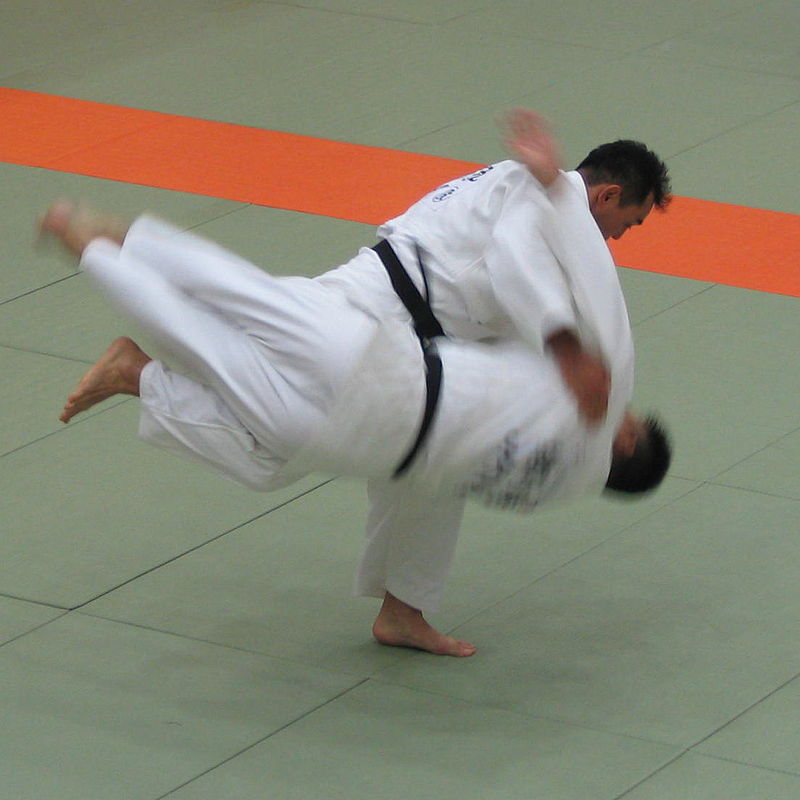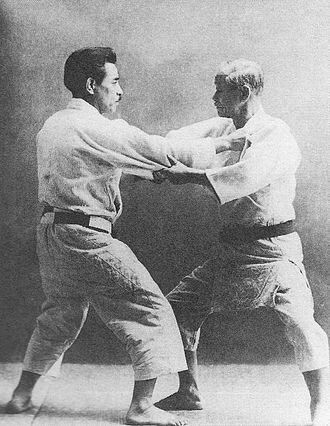From the beginning of the 20th century, jiu jitsu was known in Cuba, which means “science of softness” and is named after the combat techniques created in Japan by the Bushi (knights).
In 1882, Jigoro Kano, with the knowledge acquired from two main schools of jiu jitsu to which he added his own contributions, founded a new system of physical culture and mental training that he called Kodokan Judo. The Judo, with an incomparable moral and ethical load, took root definitively in Japan in 1886.
It is also at the beginning of the 20th century when the Japanese judo expert, the teacher Mitsuyo Maeda, fourth Dan of Ju Do Kodokan, one of the first students of the master Jigoro Kano, visited Havana on more than one occasion.
The famous Japanese fighter Mitsuyo Maeda, known professionally by Count Koma, arrived in Havana for the fourth time in January 1912, accompanied by three other Japanese judokas named Ono Akitaro, Satake Nobushiro and Ito Tokugoro.
In the 1930s, Japanese immigrants on the island taught different forms of jujutsu and Judo in an extremely secret way, only relatives or close friends of the Japanese community. But Judo would soon have its moment of boom.
Kano and Kolychkine
Jigoro Kano, the creator of judo, wanted to spread this martial art around the world and Kolychkine could crystallize that dream in Cuba ”
Kawaishi Mikonosuke, was the student that Kano sent abroad to spread the judo and he arrives in France, prepares Kolychkine and then sends him to Cuba. Kolychkine was a very straight person with an extraordinary discipline and we Cubans are not like that, but thanks to his perseverance and mastery he managed to introduce judo on the island.
Parallel to this, several teachers gave classes in karate in Cuba, including the fourth dan of Wado Ryu, nicknamed the Indonesian, who left the country around 1962. In June 1964, several Japanese citizens arrived in Cuba to transmit the technique of fishing. tuna in our country, including Masaaki Kohagura, a specialist in telecommunications, who has been recognized as the introducer on the island of the practice of Shorin-ryu karate-do, which originated in Okinawa.
But undoubtedly Andrés Kolychkine, born in Russia and with a long sporting life in boxing, wrestling and judo, has been the figure that promoted the martial arts in Cuba. He created the Cuban Judo Foundation (1951) and a year later celebrated the first National Championship at the Palacio de los Deportes.
It is necessary to explain that the categories within the Judo are expressed through the color of the ribbon, and each one has a meaning, examples: White (naivety), fifth Kyu Yellow (discovery), fourth Kyu Orange (love), third Kyu ( hope), second Blue Kyu (idealism) and first Kyu Brown (initiation to knowledge).
Already the judoka with brown ribbon is a prominent expert and the pass from one kyu to another is not only obtained by competition, but by a comprehensive assessment of the technique and competence by the sensei under his sole responsibility without mediation of any entity or superior organism as in the case of the granting of Dan grades. From there on they come what is called Dan, which means step and that according to the dan reached, which go from the first to the tenth, they are considered as sensei, teacher or teacher, expert in Judo that they are ascending in black, red and White and red. Grade 12 is reserved for Jigoro Kano.
After the revolution, fishing cooperation was established between the two countries and new Japanese immigrants arrived, albeit in a small amount. At the beginning of the 21st century, only fifteen first generation Nipponans remained on Cuban soil.
But up to the fifth degree of consanguinity they reach more than twelve hundred members of the Cuban Japanese Community, those that have presence in all the Cuban territorial divisions except in Guantánamo.
In Cuba unfortunately, it could have been greater, but the Cuban government’s own policies in a certain way scared off those who are among the most lucid and hardworking workers in the world.
Hopefully and this presence would have been more numerous, because its influence is undoubtedly in many aspects of life, the main reason that Japan is among the most developed countries in the world.
If we ask ourselves what is left of Japan in Cuba, we must say that its presence is now much greater than in our entire history. But even so, it would have come, but very well, to have a lot more Japanese essence in the Cuban melting pot.
EL JUDO EN CUBA. CULTURA FÍSICA Y ENTRENAMIENTO MENTAL. SU LLEGADA A LA ISLA.
Desde principios del siglo XX, se conoció en Cuba el jiu jitsu, que significa “ciencia de la suavidad” y se denomina así a las técnicas de combate creadas en Japón por los Bushi (caballeros).
En 1882, Jigoro Kano, con los conocimientos adquiridos de dos escuelas principales de jiu jitsu a los que agregó sus propios aportes, fundó un nuevo sistema de cultura física y de entrenamiento mental que llamó Kodokan Judo. El Judo, con una incomparable carga de moral y ética, se arraigó definitivamente en Japón en 1886.
Es también a principios del siglo XX cuando visita La Habana en más de una ocasión el experto en judo japonés , el maestro Mitsuyo Maeda , cuarto Dan del Ju Do Kodokan, uno de los primeros alumnos del maestro Jigoro Kano
El célebre luchador japonés Mitsuyo Maeda, conocido profesionalmente por el Conde Koma, llegó a La Habana por cuarta vez en enero de 1912, acompañado de otros tres judokas japoneses nombrados Ono Akitaro, Satake Nobushiro e Ito Tokugoro.
En la década de los años 1930 inmigrantes japoneses en la isla, enseñaron distintas formas de jujutsu y de Judo de un modo extremadamente secreto, solo a parientes o amigos cercanos de la comunidad japonesa. Pero el Judo pronto tendría su momento de auge.
Kano y Kolychkine
Jigoro Kano, el creador del judo, quería difundir esta arte marcial por el mundo y Kolychkine pudo cristalizar ese sueño en Cuba”
Kawaishi Mikonosuke, fue el alumno que Kano mandó al exterior para divulgar el judo y el mismo llega a Francia, prepara a Kolychkine y luego lo envía a Cuba. Kolychkine era una persona muy recta con una disciplina extraordinaria y nosotros los cubanos no somos así, pero gracias a su perseverancia y maestría logró introducir el judo en la isla.
Paralelamente varios maestros impartieron clases de karate en Cuba, destacando entre ellos el cuarto dan de Wado Ryu que apodaban el Indonesio, quien abandonó el país alrededor de 1962. En junio de 1964 llegaron a Cuba varios ciudadanos japoneses para transmitir la técnica de la pesca del atún en nuestro país, contándose entre ellos Masaaki Kohagura, especialista en telecomunicaciones, quien ha sido reconocido como el introductor en la Isla de la práctica del karate-do estilo Shorin ryu, surgido en Okinawa.
Pero sin duda Andrés Kolychkine, nacido en Rusia y con una larga vida deportiva en boxeo, lucha y judo, ha sido la figura que impulsó las artes marciales en Cuba. Creó la Fundación Cubana de Judo (1951) y un año más tarde celebra en el Palacio de los deportes el primer Campeonato Nacional.
Hay que explicar que las categorías dentro del Judo se expresan a través del color de la cinta, y cada una tiene un significado, ejemplos: Blanco (ingenuidad), quinto Kyu Amarillo (descubrimiento), cuarto Kyu Naranja (amor), tercer Kyu (esperanza), segundo Kyu Azul (idealismo) y primer Kyu Marrón (iniciación al conocimiento).
Ya el judoca con cinta marrón es un experto destacado y el pase de un kyu a otro no se obtiene solamente por competencias, sino por una valoración integral de la técnica y la competencia por parte del sensei bajo su única responsabilidad sin mediación de ninguna entidad u organismo superior como en el caso de la otorgación de los grados Dan. De ahí en adelante vienen lo que se llama Dan, que significa escalón y que según el dan alcanzado, que van desde el primero hasta el décimo, se consideran como sensei, profesor o maestro, experto en Judo que van ascendiendo de negro, rojo y blanco y rojo. El grado 12 se reserva para Jigoro Kano.
Después de la revolución se establece la cooperación pesquera entre los dos países y llegan nuevos inmigrantes nipones, aunque en una cantidad pequeña.A principios del siglo XXI solo quedaban en suelo cubano quince nipones de primera generación.
Pero hasta el quinto grado de consanguinidad llegan ascienden a más de mil doscientos los miembros de la Comunidad Japonesa Cubana, los que tienen presencia en todas las divisiones territoriales cubanos excepto en Guantánamo.
En Cuba desgraciadamente, pudo haber sido mayor, pero las propias políticas gubernamentales cubanas de cierta forma ahuyentaron a los que se encuentran entre los más lúcidos y esforzados trabajadores del mundo.
Ojalá y esta presencia hubiera sido más numerosa, pues sin duda su influencia es en muchísimos aspectos de la vida, la razón principal de que Japón se encuentre entre los países más desarrollados del mundo.
Si nos preguntamos qué queda de Japón en Cuba, hay que decir que su presencia es ahora muchísimo mayor que en toda nuestra historia. Pero así y todo, nos hubiera venido, pero muy bien, tener bastante más esencia japonesa en el melting pot cubano.
Agencies/MemoriasCubanas/Carlos Rodríguez/ Internet Photos/ Extractos/ Arnoldo Varona/TheCubanHistory.com
THE CUBAN HISTORY, HOLLYWOOD.











